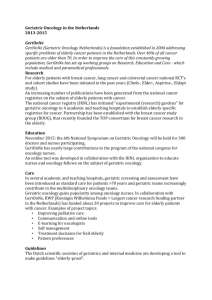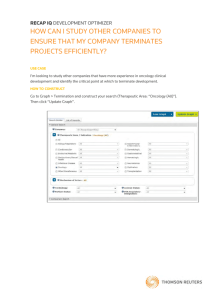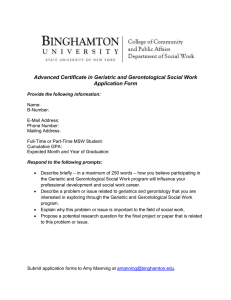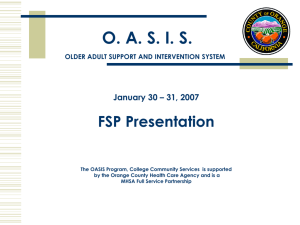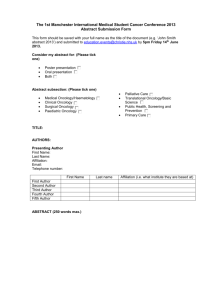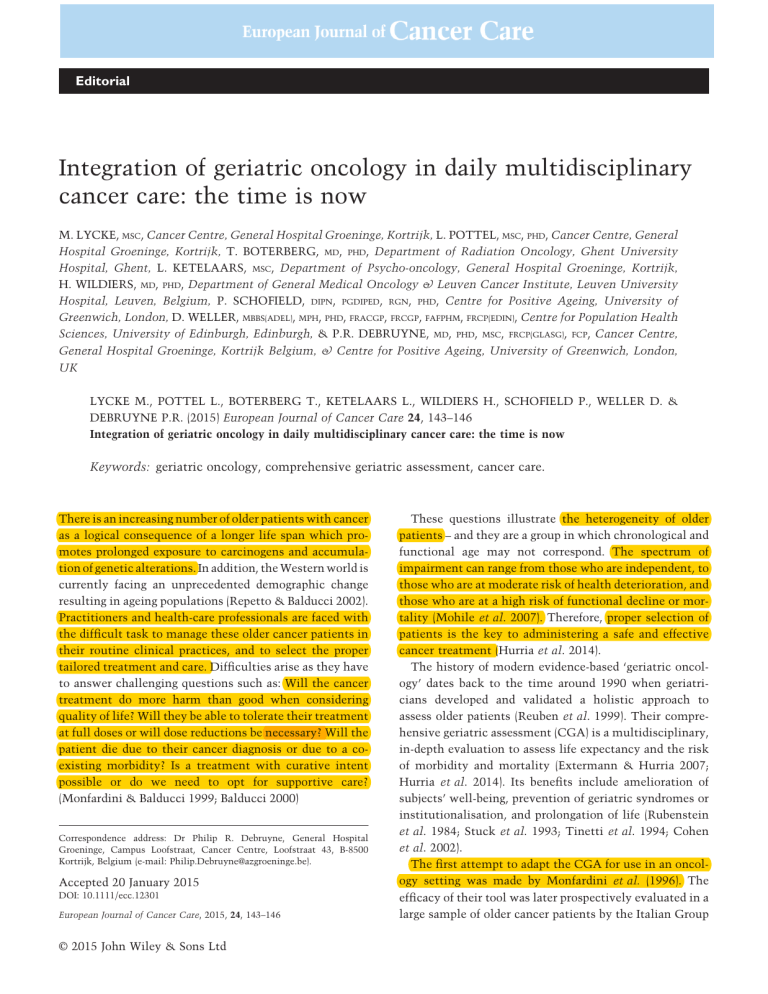
bs_bs_banner Editorial Integration of geriatric oncology in daily multidisciplinary cancer care: the time is now M. LYCKE, MSC, Cancer Centre, General Hospital Groeninge, Kortrijk, L. POTTEL, MSC, PHD, Cancer Centre, General Hospital Groeninge, Kortrijk, T. BOTERBERG, MD, PHD, Department of Radiation Oncology, Ghent University Hospital, Ghent, L. KETELAARS, MSC, Department of Psycho-oncology, General Hospital Groeninge, Kortrijk, H. WILDIERS, MD, PHD, Department of General Medical Oncology & Leuven Cancer Institute, Leuven University Hospital, Leuven, Belgium, P. SCHOFIELD, DIPN, PGDIPED, RGN, PHD, Centre for Positive Ageing, University of Greenwich, London, D. WELLER, MBBS(ADEL), MPH, PHD, FRACGP, FRCGP, FAFPHM, FRCP(EDIN), Centre for Population Health Sciences, University of Edinburgh, Edinburgh, & P.R. DEBRUYNE, MD, PHD, MSC, FRCP(GLASG), FCP, Cancer Centre, General Hospital Groeninge, Kortrijk Belgium, & Centre for Positive Ageing, University of Greenwich, London, UK LYCKE M., POTTEL L., BOTERBERG T., KETELAARS L., WILDIERS H., SCHOFIELD P., WELLER D. & DEBRUYNE P.R. (2015) European Journal of Cancer Care 24, 143–146 Integration of geriatric oncology in daily multidisciplinary cancer care: the time is now Keywords: geriatric oncology, comprehensive geriatric assessment, cancer care. There is an increasing number of older patients with cancer as a logical consequence of a longer life span which promotes prolonged exposure to carcinogens and accumulation of genetic alterations. In addition, the Western world is currently facing an unprecedented demographic change resulting in ageing populations (Repetto & Balducci 2002). Practitioners and health-care professionals are faced with the difficult task to manage these older cancer patients in their routine clinical practices, and to select the proper tailored treatment and care. Difficulties arise as they have to answer challenging questions such as: Will the cancer treatment do more harm than good when considering quality of life? Will they be able to tolerate their treatment at full doses or will dose reductions be necessary? Will the patient die due to their cancer diagnosis or due to a coexisting morbidity? Is a treatment with curative intent possible or do we need to opt for supportive care? (Monfardini & Balducci 1999; Balducci 2000) Correspondence address: Dr Philip R. Debruyne, General Hospital Groeninge, Campus Loofstraat, Cancer Centre, Loofstraat 43, B-8500 Kortrijk, Belgium (e-mail: Philip.Debruyne@azgroeninge.be). Accepted 20 January 2015 DOI: 10.1111/ecc.12301 European Journal of Cancer Care, 2015, 24, 143–146 © 2015 John Wiley & Sons Ltd These questions illustrate the heterogeneity of older patients – and they are a group in which chronological and functional age may not correspond. The spectrum of impairment can range from those who are independent, to those who are at moderate risk of health deterioration, and those who are at a high risk of functional decline or mortality (Mohile et al. 2007). Therefore, proper selection of patients is the key to administering a safe and effective cancer treatment (Hurria et al. 2014). The history of modern evidence-based ‘geriatric oncology’ dates back to the time around 1990 when geriatricians developed and validated a holistic approach to assess older patients (Reuben et al. 1999). Their comprehensive geriatric assessment (CGA) is a multidisciplinary, in-depth evaluation to assess life expectancy and the risk of morbidity and mortality (Extermann & Hurria 2007; Hurria et al. 2014). Its benefits include amelioration of subjects’ well-being, prevention of geriatric syndromes or institutionalisation, and prolongation of life (Rubenstein et al. 1984; Stuck et al. 1993; Tinetti et al. 1994; Cohen et al. 2002). The first attempt to adapt the CGA for use in an oncology setting was made by Monfardini et al. (1996). The efficacy of their tool was later prospectively evaluated in a large sample of older cancer patients by the Italian Group M. LYCKE ET AL. of Geriatric Oncology from 1995 to 1998 (Repetto & Balducci 2002; Repetto et al. 2002). Around the beginning of the new century, clinical studies validated the importance of the use of a CGA in routine oncology practice (Monfardini & Balducci 1999; Extermann & Hurria 2007). A trial including 660 women diagnosed with primary breast cancer showed that the domains included within a CGA are associated with poor treatment tolerance and predict mortality at 7 years of follow-up (Clough-Gorr et al. 2010). Another landmark study in elderly patients with ovarian cancer illustrated that functional dependence, as assessed with a CGA, is associated with a risk of chemotherapy toxicity (Freyer et al. 2005). Decoster et al. (2013) showed that CGA influences oncological treatment decisions and may trigger the use of less aggressive as well as more aggressive treatments (Decoster et al. 2013). Moreover, a trial conducted in head and neck cancer patients illustrated that a CGA provides an indication of the health-related quality of life (QoL). With this information, physicians could tailor care and thus improve patients’ QoL (Pottel et al. 2014). Through efforts made during the last decade, tremendous progress has been made towards the optimisation of comprehensive geriatric assessments in routine multidisciplinary cancer care (Pottel et al. 2014; Sattar et al. 2014). Researchers have also conducted trials on the most optimal screening tool to detect those patients in need of a CGA (Kenis et al. 2013; Soubeyran et al. 2014). Others have proposed and validated new measures for use within the assessment (Ketelaars et al. 2013; Lycke et al. 2014). As a result, a CGA has been endorsed as the key treatment approach in older cancer patients, by several international expert panels. These include: the National Comprehensive Cancer Network, the European Organisation for Research and Treatment of Cancer, and the Society of Geriatric Oncology (Pallis et al. 2010; Decoster et al. 2014; Hurria et al. 2014; Wildiers et al. 2014). Current senior adult oncology care guidelines can be consulted on their respective websites (http://www.nccn.org; http:// www.eortc.org; http://www.siog.org). Despite the growing evidence, there remains high variability among countries and centres in the application of the guidelines, mainly because of shortage of staff and other economic and institutional constraints (Jonker et al. 2014). Several specialised ‘geriatric oncology’ units are being established, but since cancer is a disease of older people, we believe that a geriatric evaluation and geriatric interventions should become available to all older individuals affected by cancer. Looking beyond oncology settings, elderly patients with cancer need community-based care which complements 144 their specialist treatments. Primary care features, to a growing extent, in new models of cancer treatment and survivorship, and there is evidence of increasing involvement with elderly cancer patients (Bowman et al. 2010). Accordingly, there are widespread calls for the care of elderly patients with cancer to be better integrated between primary and secondary care (Buntinx et al. 2014); these patients will typically have multiple comorbidities requiring both generalist and specialist approaches. With this ‘Ageing and Cancer’ themed issue, the European Journal of Cancer Care wants to support researchers who aim to move geriatric oncology forward (Debruyne et al. 2014). It is therefore our pleasure to present several interesting studies that look into a range of research questions from different angles. O’Donovan et al. (2015) introduce new expert consensus panel guidelines on geriatric assessments in oncology. As a result of their Delphi study, the expert panel recommends criteria that should be included when introducing CGAs in a clinical geriatric oncology programme in Ireland. Their findings should be transferrable to many other countries and health systems (O’Donovan et al. 2015). Chau et al. (2015) and Qiu et al. (2015) both conducted traditional clinical trials comparing younger and older patients. The latter study looks at differences in clinicopathological features and prognosis of triple-negative breast cancer (TNBC) between younger (<60 years old) and elderly (≥60 years old) patients. They emphasise that physicians need to be careful when choosing adjuvant treatments for older patients with TNBC. The retrospective nature of their study and the definition of TNBC is a limitation of the study, and there is definitely a need for more research (funding) in this area in the future so that prospective trials are possible in older patients (Qiu et al. 2015). Chau et al. (2015) address clinical outcomes following neoadjuvant cisplatin-based chemotherapy for bladder cancer in both subgroups. They suggest that older patients receiving neo-adjuvant chemotherapy followed by cystectomy or radiotherapy can show similar clinical outcomes as younger patients if they present with a good functional ability and limited comorbidities (Chau et al. 2015). A major caveat in this and many other studies is that a CGA was not included and that the population under study may not be applicable to other (more vulnerable) older patient populations. Indeed, implementation of CGA in daily practice will not only benefit patients directly, but also indirectly since one can anticipate a better quality of future prospective and retrospective clinical research. Even in the case where the implementation of a CGA in daily practice is not possible due to economic reasons, we do would strongly advocate to implement a minimal assessment under the form of a © 2015 John Wiley & Sons Ltd Geriatric oncology in daily cancer care G8 score. This simple and reliable (screening) instrument has on its own the capacity to identify vulnerable patients and has a strong prognostic value for functional decline and overall survival (Kenis et al. 2013). The study of Hamama-Raz et al. (2015) aimed at exploring whether patients’ QoL and functional dependence could have a reciprocal effect on each other over time. Interestingly, it showed that an assessment of QoL can predict functional decline in older cancer patients receiving treatment REFERENCES Balducci L. (2000) Geriatric oncology: challenges for the new century. European Journal of Cancer 36, 1741–1754. Bol N., Smets E.M.A., Eddes E.H., De Haes J.C.J.M., Loos E.F. & Van Weert J.C.M. (2015) Illustrations enhance older colorectal cancer patients’ website satisfaction and recall of online cancer information. European Journal of Cancer Care 24, 213–223. Bowman K.F.1., Rose J.H., Deimling G.T., Kypriotakis G. & O’Toole E.E. (2010) Primary care physicians’ involvement in the cancer care of older longterm survivors. Journal of Aging and Health 22, 673–686. doi: 10.1177/ 0898264310373501 Buntinx F., Campbell C. & van den Akker M. (2014). Cancer in the Elderly Journal of Cancer Epidemiology (2014): 872029. PMC. Web. 20 Jan. 2015. Chau C., Wheater M., Geldart T. & Crabb S.J. (2015) Clinical outcomes following neoadjuvant cisplatin based chemotherapy for bladder cancer in elderly compared to younger patients. European Journal of Cancer Care 24, 155–162. Clough-Gorr K.M., Stuck A.E., Thwin S.S. & Silliman R.A. (2010) Older breast cancer survivors: geriatric assessment domains are associated with poor tolerance of treatment adverse effects and predict mortality over 7 years of followup. Journal of Clinical Oncology 28, 380– 386. Cohen H.J., Feussner J.R., Weinberger M., Carnes M., Hamdy R.C., Hsieh F., Phibbs C., Courtney D., Lyles K.W., May C., McMurtry C., Pennypacker L., Smith D.M., Ainslie N., Hornick T., Brodkin K. & Lavori P. (2002) A controlled trial of inpatient and outpatient geriatric evaluation and management. The New England Journal of Medicine 346, 905–912. Debruyne P.R., Knott V.E. & Weller D. (2014) Themes for our journal: 2014– 2016. European Journal of Cancer Care 23, 285–287. Decoster L., Kenis C., Van Puyvelde K., Flamaing J., Conings G., De Greve J., © 2015 John Wiley & Sons Ltd (Hamama-Raz et al. 2015). Lastly, Bol et al. (2015) addressed website satisfaction and recall of online cancer information in older colorectal cancer patients and indicate that there is also great potential for e-health in this patient population (Bol et al. 2015). In conclusion, we argue that the time to integrate geriatric oncology into our daily practices has arrived. It is another paradigm of multidisciplinary cancer care that will gain further importance in the near future. Mets T., Milisen K., Lobelle J.P. & Wildiers H. (2013) The influence of clinical assessment (including age) and geriatric assessment on treatment decisions in older patients with cancer. Journal of Geriatric Oncology 4, 235–241. Decoster L., Van Puyvelde K., Mohile S., Wedding U., Basso U., Colloca G., Rostoft S., Overcash J., Wildiers H., Steer C., Kimmick G., Kanesvaran R., Luciani A., Terret C., Hurria A., Kenis C., Audisio R. & Extermann M. (2014) Screening tools for multidimensional health problems warranting a geriatric assessment in older cancer patients: an update on SIOG recommendationsdagger. Annals of Oncology 26, 288–300. Extermann M. & Hurria A. (2007) Comprehensive geriatric assessment for older patients with cancer. Journal of Clinical Oncology 25, 1824–1831. Freyer G., Geay J.F., Touzet S., Provencal J., Weber B., Jacquin J.P., Ganem G., Tubiana-Mathieu N., Gisserot O. & Pujade-Lauraine E. (2005) Comprehensive geriatric assessment predicts tolerance to chemotherapy and survival in elderly patients with advanced ovarian carcinoma: a GINECO study. Annals of Oncology 16, 1795–1800. Hamama-Raz Y., Shrira A., Ben-Ezra M. & Palgi Y. (2015) The recursive effects of quality of life and functional limitation among older adult cancer patients: evidence from the survey of health and retirement in Europe. European Journal of Cancer Care 24, 205–212. Hurria A., Wildes T., Blair S.L., Browner I.S., Cohen H.J., Deshazo M., Dotan E., Edil B.H., Extermann M., Ganti A.K.P., Holmes H.M., Jagsi R., Karlekar M.B., Keating N.L., Korc-Grodzicki B., McKoy J.M., Medeiros B.C., Mrozek E., O’Connor T., Rugo H.S., Rupper R.W., Silliman R.A., Stirewalt D.L., Tew W.P., Walter L.C., Weir A.B., Bergman M.A. & Sundar H. (2014) Senior adult oncology, version 2.2014. Journal of the National Comprehensive Cancer Network 12, 82–126. Jonker J.M., Smorenburg C.H., Schiphorst A.H., Van Rixtel B., Portielje J.E. & Hamaker M.E. (2014) Geriatric oncology in the Netherlands: a survey of medical oncology specialists and oncology nursing specialists. European Journal of Cancer Care 23, 803–810. Kenis C., Bron D., Libert Y., Decoster L., Van Puyvelde K., Scalliet P., Cornette P., Pepersack T., Luce S., Langenaeken C., Rasschaert M., Allepaerts S., Van Rijswijk R., Milisen K., Flamaing J., Lobelle J.P. & Wildiers H. (2013) Relevance of a systematic geriatric screening and assessment in older patients with cancer: results of a prospective multicentric study. Annals of Oncology 24, 1306–1312. Ketelaars L., Pottel L., Lycke M., Goethals L., Ghekiere V., Santy L., Boterberg T., van den Noortgate N., Pottel H. & Debruyne P.R. (2013) Use of the Freund clock drawing test within the Mini-Cog as a screening tool for cognitive impairment in elderly patients with or without cancer. Journal of Geriatric Oncology 4, 174–182. Lycke M., Ketelaars L., Boterberg T., Pottel L., Pottel H., Vergauwe P., Goethals L., Van Eygen K., Werbrouck P., Debruyne D., Derijcke S., Borms M., Ghekiere V., Wildiers H. & Debruyne P.R. (2014) Validation of the Freund Clock Drawing Test as a screening tool to detect cognitive dysfunction in elderly cancer patients undergoing comprehensive geriatric assessment. Psycho-Oncology 23, 1172– 1177. Mohile S.G., Bylow K., Dale W., Dignam J., Martin K., Petrylak D.P., Stadler W.M. & Rodin M. (2007) A pilot study of the vulnerable elders survey-13 compared with the comprehensive geriatric assessment for identifying disability in older patients with prostate cancer who receive androgen ablation. Cancer 109, 802–810. Monfardini S. & Balducci L. (1999) A comprehensive geriatric assessment (CGA) is necessary for the study and the management of cancer in the elderly. European Journal of Cancer 35, 1771–1772. Monfardini S., Ferrucci L., Fratino L., Del Lungo I., Serraino D. & Zagonel V. (1996) Validation of a multidimensional 145 M. LYCKE ET AL. evaluation scale for use in elderly cancer patients. Cancer 77, 395–401. O’Donovan A., Mohile S.G. & Leech M. (2015) Expert Consensus Panel Guidelines on Geriatric Assessment in Oncology. European Journal of Cancer Care, in press. Pallis A.G., Fortpied C., Wedding U., Van Nes M.C., Penninckx B., Ring A., Lacombe D., Monfardini S., Scalliet P. & Wildiers H. (2010) EORTC elderly task force position paper: approach to the older cancer patient. European Journal of Cancer 46, 1502–1513. Pottel L., Lycke M., Boterberg T., Pottel H., Goethals L., Duprez F., van den Noortgate N., De Neve W., Rottey S., Geldhof K., Buyse V., Kargar-Samani K., Ghekiere V. & Debruyne P.R. (2014) Serial comprehensive geriatric assessment in elderly head and neck cancer patients undergoing curative radiotherapy identifies evolution of multidimensional health problems and is indicative of quality of life. European Journal of Cancer Care 23, 401–412. Qiu D.J., Xue Y.X., Wang D.J. & Li R. (2015) Clinicopathological features and prognosis of triple-negative breast cancer: a comparison between younger (<60) and elderly (≥60) patients. European Journal of Cancer Care, in press. 146 Repetto L. & Balducci L. (2002) A case for geriatric oncology. The Lancet Oncology 3, 289–297. Repetto L., Fratino L., Audisio R.A., Venturino A., Gianni W., Vercelli M., Parodi S., Dal Lago D., Gioia F., Monfardini S., Aapro M.S., Serraino D. & Zagonel V. (2002) Comprehensive geriatric assessment adds information to Eastern Cooperative Oncology Group performance status in elderly cancer patients: an Italian Group for Geriatric Oncology Study. Journal of Clinical Oncology 20, 494–502. Reuben D.B., Frank J.C., Hirsch S.H., McGuigan K.A. & Maly R.C. (1999) A randomized clinical trial of outpatient comprehensive geriatric assessment coupled with an intervention to increase adherence to recommendations. Journal of the American Geriatrics Society 47, 269–276. Rubenstein L.Z., Josephson K.R., Wieland G.D., English P.A., Sayre J.A. & Kane R.L. (1984) Effectiveness of a geriatric evaluation unit. A randomized clinical trial. The New England Journal of Medicine 311, 1664–1670. Sattar S., Alibhai S., Wildiers H. & Puts M. (2014) How to implement a geriatric assessment in your clinical practice. The Oncologist 19, 1056– 1068. Soubeyran P., Bellera C., Goyard J., Heitz D., Cure H., Rousselot H., Albrand G., Servent V., Jean O.S., Van Praagh I., Kurtz J.E., Perin S., Verhaeghe J.L., Terret C., Desauw C., Girre V., Mertens C., Mathoulin-Pelissier S. & Rainfray M. (2014) Screening for vulnerability in older cancer patients: the ONCODAGE prospective multicenter cohort study. PLoS ONE 9, e115060. Stuck A.E., Siu A.L., Wieland G.D., Adams J. & Rubenstein L.Z. (1993) Comprehensive geriatric assessment: a meta-analysis of controlled trials. Lancet 342, 1032– 1036. Tinetti M.E., Baker D.I., McAvay G., Claus E.B., Garrett P., Gottschalk M., Koch M.L., Trainor K. & Horwitz R.I. (1994) A multifactorial intervention to reduce the risk of falling among elderly people living in the community. The New England Journal of Medicine 331, 821–827. Wildiers H., Heeren P., Puts M., Topinkova E., Janssen-Heijnen M.L., Extermann M., Falandry C., Artz A., Brain E., Colloca G., Flamaing J., Karnakis T., Kenis C., Audisio R.A., Mohile S., Repetto L., Van Leeuwen B., Milisen K. & Hurria A. (2014) International Society of Geriatric Oncology consensus on geriatric assessment in older patients with cancer. Journal of Clinical Oncology 32, 2595–2603. © 2015 John Wiley & Sons Ltd
